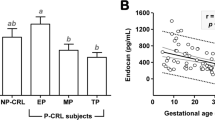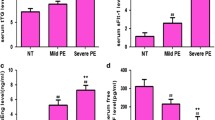Abstract
The purpose of this study is to investigate whether endothelial dysfunction, as assessed by elevated cellular fibronectin (cFN), in women with preeclampsia is associated with an increased risk of preterm and/or small-for-gestational-age (SGA) births. Maternal plasma cFN was measured by enzyme-linked immunosorbent assay in samples collected at admission to delivery in 605 normotensive women, 171 women with transient hypertension, and 187 women with preeclampsia. Logistic regression was used to estimate the risk for preterm delivery, SGA, or both. Elevated cFN in women with preeclampsia was associated with an increased risk of both preterm and SGA births (odds ratio, 3.0; confidence interval [CI], 1.0–.7) compared with women with preeclampsia without elevated cFN. The risk of preterm birth was 14.7-fold higher (CI, 8.1–26.7) and the risk of SGA was 6.8-fold higher (CI, 3.5–13.1) in women with preeclampsia, hyperuricemia, and elevated cFN compared with normotensive women. Elevated cFN is prevalent among women with preeclampsia and identifies women at increased risk of preterm delivery and SGA.
Similar content being viewed by others
References
Roberts JM Pregnancy related hypertension. In: Creasy RK, Resnik R, eds. Maternal Fetal Medicine. Philadelphia, PA: WB Saunders; 1998:833–872.
Duley L. Maternal mortality associated with hypertensive disorders of pregnancy in Africa, Asia, Latin America and the Caribbean. Br J Obstet Gynaecol. 1992;99:547–553.
Goldenberg RL, Rouse DJ Prevention of premature birth. N Engl J Med. 1998;339:313–320.
Zhang J., Klebanoff MA, Roberts JM Prediction of adverse outcomes by common definitions of hypertension in pregnancy. Obstet Gynecol. 2001;97:261–267.
Roberts JM, Bodnar LM, Lain KY, et al. Uric acid is as important as proteinuria in identifying fetal risk in women with gestational hypertension. Hypertension. 2005;46:1263–1269.
Redman CW, Sargent IL Latest advances in understanding preeclampsia. Science. 2005;308:1592–1594.
Roberts JM Objective evidence of endothelial dysfunction in preeclampsia. Am J Kidney Dis. 1999;33:992–997.
Roberts JM Endothelial dysfunction in preeclampsia. Semin Reprod Endocrinol. 1998;16:5–15.
Roberts JM Preeclampsia: not simply pregnancy-induced hypertension. Hosp Pract (Off Ed). 1995;30:25–28, 31–36.
Roberts JM, Taylor RN, Musci TJ, Rodgers GM, Hubel CA, McLaughlin MK Preeclampsia: an endothelial cell disorder. Am J Obstet Gynecol. 1989;161:1200–1204.
Chavarria ME, Lara-Gonzalez L., Gonzalez-Gleason A., Sojo I., Reyes A. Maternal plasma cellular fibronectin concentrations in normal and preeclamptic pregnancies: a longitudinal study for early prediction of preeclampsia. Am J Obstet Gynecol. 2002; 187:595–601.
Powers RW, Evans RW, Ness RB, Crombleholme WR, Roberts JM Homocysteine and cellular fibronectin are increased in preeclampsia, not transient hypertension of pregnancy. Hypertens Pregnancy. 2001;20:69–77.
Powers RW, Evans RW, Majors AK, et al. Plasma homocysteine concentration is increased in preeclampsia and is associated with evidence of endothelial activation. Am J Obstet Gynecol. 1998;179:1605–1611.
Friedman SA, de Groot CJM, Taylor RN, Heilbron DC, Roberts JM Plasma cellular fibronectin as a measure of endothelial involvement in preeclampsia and intrauterine growth retardation. Am J Obstet Gynecol. 1994;170:838–841.
Taylor RN, Crumbleholme WR, Friedman SA, Jones LA, Casal DC, Roberts JM High plasma cellular fibronectin levels correlate with biochemical and clinical features of preeclampsia but cannot be attributed to hypertension alone. Am J Obstet Gynecol. 1991;165:895–901.
Lockwood C., Peters J. Increased plasma levels of ED1+ cellular fibronectin precede the clinical signs of preeclampsia. Am J Obstet Gynecol. 1990;162:358–362.
Gifford RW, August PA, Cunningham G., et al. Report of the National High Blood Pressure Education Program Working Group on High Blood Pressure in Pregnancy. Am J Obstet Gynecol. 2000;183:S1–S22.
Lind T., Godfrey KA, Otun H., Philips PR Changes in serum uric acid concentrations during normal pregnancy. Br J Obstet Gynaecol. 1984;91:128–132.
Roberts JM, Bodnar LM, Lain KY, et al. Uric acid is as important as proteinuria in identifying fetal risk in women with gestational hypertension. Hypertension. 2005;46:1263–1269.
Bodnar LM, Ness RB, Markovic N., Roberts JM The risk of preeclampsia rises with increasing prepregnancy body mass index. Ann Epidemiol. 2005;15:475–482.
Lain KY, Krohn MA, Roberts JM Second pregnancy outcomes following preeclampsia in a first pregnancy. Hypertens Pregnancy. 2005;24:159–169.
Frohlich EP Elevated fibronectin levels and preeclampsia [letter]. Am J Obstet Gynecol. 1989;160:1022–1023.
Yoshida A., Nakao S., Kobayashi M., Kobayashi H. Flow-mediated vasodilation and plasma fibronectin levels in preeclampsia. Hypertension. 2000;36:400–404.
Islami D., Shoukir Y., Dupont P., Campana A., Bischof P. Is cellular fibronectin a biological marker for pre-eclampsia? Eur J Obstet Gynecol Reprod Biol. 2001;97:40–45.
Ostlund E., Hansson LO, Bremme K. Fibronectin is a marker for organ involvement and may reflect the severity of preeclampsia. Hypertens Pregnancy. 2001;20:79–87.
Peters J., Maunder R., Woolf A., Cochrane C., Ginsberg M. Elevated plasma levels of ED1+ (“cellular”) fibronectin in patients with vascular injury. J Lab Clin Med. 1989;113: 586–597.
Murphy-Ullrich JE, Mosher DF Fibronectin and disease processes. In: Perejda UJ, ed. Connective Tissue Disease: Molecular Pathology of the Extracellular Matrix. New York, NY: Marcel Dekker, 1986:455–473.
Austgulen R., Lien E., Vince G., Redman CW Increased maternal plasma levels of soluble adhesion molecules (ICAM-1, VCAM-1, E-selectin) in preeclampsia. Eur J Obstet Gynecol Reprod Biol. 1997;71:53–58.
Djurovic S., Schjetlein R., Wisloff F., Haugen G., Berg K. Increased levels of intercellular adhesion molecules and vascular cell adhesion molecules in pre-eclampsia. Br J Obstet Gynaecol. 1997;104:466–470.
Higgins JR, Papayianni A., Brady HR, Darling MRN, Walshe JJ Circulating vascular cell adhesion molecule-1 in pre-eclampsia, gestational hypertension, and normal pregnancy- evidence of selective dysregulation of vascular cell adhesion molecule-1 homeostasis in pre-eclampsia. Am J Obstet Gynecol. 1998;179:464–469.
Krauss T., Emons G., Kuhn W., Augustin HG Predictive value of routine circulating soluble endothelial cell adhesion molecule measurements during pregnancy. Clin Chem. 2002;48: 1418–1425.
Kim S.-Y., Ryu H.-M, Yang JH, et al. Maternal serum levels of VCAM-1, ICAM-1 and E-selectin in preeclampsia. J Korean Med Sci. 2004;19:688–692.
Vadachkoria S., Sanchez SE, Qiu C., Muy-Rivera M., Malinow MR, Williams MA Hyperhomocyst(e)inemia and elevated soluble vascular cell adhesion molecule-1 concentrations are associated with an increased risk of preeclampsia. Gynecol Obstet Invest. 2004;58:133–139.
Taylor RN, Crombleholme WR, Friedman SA, Jones LA, Casal DC, Roberts JM High plasma cellular fibronectin levels correlate with biochemical and clinical features of preeclampsia but cannot be attributed to hypertension alone. Am J Obstet Gynecol. 1991;165:895–901.
Friedman SA, de Groot CJ, Taylor RN, Golditch BD, Roberts JM Plasma cellular fibronectin as a measure of endothelial involvement in preeclampsia and intrauterine growth retardation. Am J Obstet Gynecol. 1994;170:838–841.
Paarlberg KM, de Jong CL, van Geijn HP, van Kamp GJ, Heinen AG, Dekker GA Total plasma fibronectin as a marker of pregnancy-induced hypertensive disorders: a longitudinal study. Obstet Gynecol. 1998;91:383–388.
Author information
Authors and Affiliations
Corresponding author
Additional information
This project was supported by the National Institutes of Health grant P01-HD30367 and by funds received from the National Institutes of Health/National Center for Research Resources/General Clinic Research Centers grant M01-RR00056.Presented at the 15th World Congress of the International Society for Study of Hypertension in Pregnancy, Lisbon, Portugal, July 2–5, 2006.
Rights and permissions
About this article
Cite this article
Powers, R.W., Catov, J.M., Bodnar, L.M. et al. Evidence of Endothelial Dysfunction in Preeclampsia and Risk of Adverse Pregnancy Outcome. Reprod. Sci. 15, 374–381 (2008). https://doi.org/10.1177/1933719107311780
Published:
Issue Date:
DOI: https://doi.org/10.1177/1933719107311780




